By Manon
Meilgaard for the Metro Times,
Jan. 14th, 1987
ON THE FRONTIER
Bradley Jones and the
spirit of the Cass Corridor
BY MANON MEILGAARD
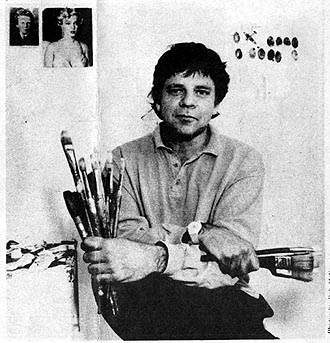
"Detroit is a good place to make
art," according to Bradley Jones, pensively gazing through
the large window of his studio across from the Eastern Market.
"Detroit has a special kind of intensity, and it produces a
variety of styles you don't find anywhere else. But don't call it
regional art. There's no such thing anymore." One of the
original Cass Corridor artists, Jones, a youthful-looking 42, is
known by his multitude of friends to have a big heart, lots of
idealism, an infectious sense of humor and a mind like a sharply
honed rapier. He is also something of a maverick-an aesthetic
frontiersman.
Shifting up and down from chair to window, Jones ruminated on a
variety of subjects, including poetry, personalities, politics,
painting and his native Detroit. "Look
at those faces," he said, pointing to a group of mostly black
people waiting at a bus stop. "I could spend hours sketching
from this window. There are some fabulous characters out
there."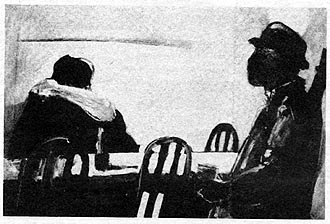
He was noticeably less enthusiastic, however, about a nearby,
near-derelict -building. "Imagine a fine old building like
that being left to rot. Our politicians and lousy architects are
more concerned with erecting monstrosities like the Renaissance
Center than with restoring old houses. Detroit is a holy city. We
are standing on layers of prehistory and buried cultures, Indian,
French and English. Detroit should be treated with respect."
This restless energy is reflected in a large stack of stunning,
figurative paintings in his studio, ready for an exhibition at the
Feigenson Gallery.
Jones' primary focus is and always has been the human figure, but
these paint jugs haven come a long way from the dazzling colors,
cartoon like styles and hybrid
human/animal forms of some of his earlier work. The colors are now
more muted, with predominating blue tones and skin tones varying
between pinkish reds and luminous whites. To achieve a - more
dramatic or startling effect, Jones may deliberately distort
anatomy.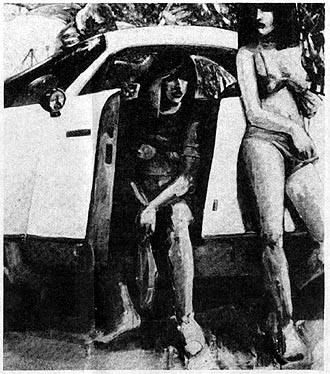
Racially mixed figures of both sexes (clothed,
nude or half-nude) depict situations and confrontations that seem
fraught
with tension-often verging on the ominous. Is the naked woman
tapping the shoulder of a fully clothed male in a large seascape
canvas merely being playful, or does she have a concealed weapon
behind her back? Is the male figure peeking over the roof of a
parked car where two young women are un-dressing a harmless
voyeur, or is he intent on rape, or even mayhem? Are the two
heavily made-up, provocatively dressed women standing by another
parked car prostitutes or angels?
Jones, who paints from imagination, sketches or photographs, and
occasionally uses models, is not about to give any clues. Each
painting portrays a modern day situation and has a surprise
element, but interpretation is in the eye of the viewer. He
shuns acrylics, except for underpainting, and always uses oils for
surfaces. "There's no painterliness in acrylics," he
explained. "Rembrandt never would have used them." Apart
from Rembrandt, Jones has great respect for contemporary British
painter David Hockney. "Hockney's one of the few guys who
escaped the big-business corruption of artists in New York,"
he said. "Things going on in the art scene there make the
Iran Affair look like small potatoes"
It's almost inevetable that Jones should be labeled a social
realist or a social saterist in todays artistic climate, where
labels are as numerous as lottery-stake promotions sent through
the mail. There is, though, a hint of the expressive realism of
Georges Grosz in. Jones' intensely personal imagery and style-a
style that attracts many Detroit-area followers, artists and
non-artists alike. European car importer Joel Landy, low-key
dark-horse patron of the arts and generous supporter of Detroit
artists, goes so far as to say, "I not only admire Bradley as
a person, but consider him to be one of the most creative artists
of this century."
Jones attended the Center for Creative Studies, Wayne State
University (B.F.A. and M.F.A.) and received a fellowship at Ohio's
Kent State in 1969. Initially, his interest in pursuing art was
met with opposition from his father, a high-powered salesman.
"My dad used to call me a bum," quipped Jones, "but
now he sees me as a fairly successful bum."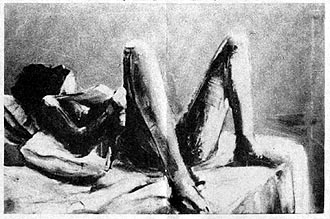
During the 1960s, Jones became actively involved in the
anti-Vietnam movement, and as one of the earliest members of the
avant-garde Cass Corridor group of artists, had studios in both
Convention Hall and Common Ground. Spanning a chronological
parameter circa 1963-1977, the Corridor created a significant
chapter in Detroit's cultural life (both display arts and poetry),
and continues to be a source of inspiration to younger,
second-generation artists. True, many of the seminal artists,
including Brenda Goodman, Ellen Phelan, Nancy Mitchnick, John
Egner and Stephen Foust have moved to other pastures (mostly New
York). Others, like Bob Sestock, John Piet, Gordon Newton, James
Crawford (and Jones) are still working In Detroit. The memorable
1980 Kick Out the Jams exhibition at the Detroit Institute of Arts
was a tribute to many of the Cass Corridor artists. Said Jones,
"The Corridor as such might not exist anymore, but the spirit
and attitude live on."
Jones compares the DIA to a giant book supported by two vital
bookends- the WSU art department and the Center for Creative
Studies. He positively recalls former DIA curator of contemporary
arts Sam Wagstaff, who played a key role in organizing the Jams.
"Sam really cared about Detroit artists, and he did a hell of
a lot of much-needed stirring up around there. If the new, guy
(Jan van der Marck) lives up to his reputation, I'll support him
to the hilt, and so I think will many other Michigan artists-but I
hope he kicks ass."
Since 1970, Jones has taught at Wayne County
Community College. "This gives me a lot of satisfaction"
he said. "My students are of all backgrounds, races and ages
- many of them are the underprivileged, and for some, it's their
first exposure to art. And since I'm more interested in making art
than showing or selling it, teaching gives me an income."
With typical candor, he admits to being a reformed alcoholic
beginning two years ago, following a long bout of excessive
drinking. "it seems to be the writers' and artists'
disease," he mused. "I became a demon for a time, a
Jekyll and Hyde character. I hit bottom when I started to
hemorrhage from the throat and ended up in intensive care, almost
dead. Getting over that was a rebirth, and I have to thank my
wife, Cathy, for saving my life and sanity."
Jones is not the type to indulge in maudlin self-pity or
sermonizing. According to those who know him best, he functioned
amazingly well even during his fight with alcohol. "There's
no one like Bradley," said Carl Kamulski, co-director of the
Michigan Gallery. "I knew him at school, and we both teach at
WCCC. He is one of the most consistent and serious artists I have
ever known, and he doesn't align himself to any particular group.
Bradley is involved with students, Detroit musicians and poets, as
well as artists. He has a great talent and he is a great
friend."
Bradley Jones' paintings will
be on display through Feb. 7 at Feigenson Gallery. Call 873-7322
for more information.
Manon Meilgaard is a frequent
contributor to the Metro Times on the local art scene.
Photos by Bob Mckeown
By Manon
Meilgaard for the Metro Times,
Oct. 4th, 1989
Bradley Jones
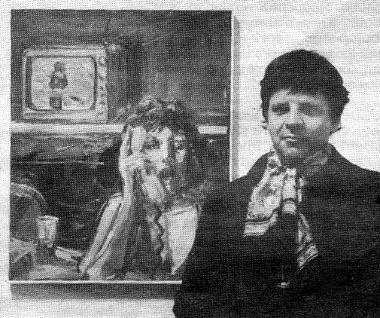
Bradley Jones-an extraordinary
being, an untimely death.
How to comprehend the darker depths of the human psyche? How to
convey the essence, the multifaceted persona of a supremely gifted
artist who, in turn, could be visionary, biting, sensitive,
humorous, provocative, compassionate and endlessly seeking? Who
can, possibly explain the pain and inner conflicts Jones was
feeling when, on Sept. 24. the 45-year-old Detroit painter died of
self-inflicted gunshot wounds?
The Detroit art world grieves. Talking to his wife, Catherine
DeMay (artist and general manager of the Detroit Focus Gallery)
was painful.
"Bradley wanted everyone to Interpret his work In their own
way," DeMay said. "His paintings were sensitive and
immediate, and yet so mysterious. One look from Bradley meant more
than a thousand words. . . what more can I say?"
Said Mary Preston, owner of the Feigenson/ Preston Gallery In
Birmingham, who has known Jones for over 20 years: "Who knows
what must have been going on in Bradley's mind? Perhaps the colors
faded, becoming gray and then black. He was a man without malice
or guile. He was giving. He had no enemies, except perhaps
himself. He made exciting. truthful, rich and mysterious
paintings, and his death is a tragic loss for the Detroit art
community."
Jones was born In Detroit and remained an adamant, if somewhat
disillusioned. Detroiter throughout his life. This writer vividly
remembers him proclaiming ("On the Frontier." MT, Jan.
14-20, 1987). "Our politicians and lousy architects are more
concerned with erecting monstrosities like the Renaissance Center
than with restoring old houses. Detroit Is a holy city. We are
standing on layers of prehistory and buried cultures: Indian.
French and English. Detroit should be treated with respect."
After studying at the Center for Creative Studies, Jones earned
his BFA and MFA degrees at Wayne State University. In 1970, he
became a denizen of the Common Ground art complex on Cass, near
Willis, and was a seminal member of the Cass Corridor artists
movement during the early '70s. In those heady days. his work was
included In 'Kick Out the Jams: Detroit's Can Corridor 1963-77' at
the Detroit Institute of Arts. "The Corridor as such."
he once said, "might not exist anymore, but the spirit and
attitude live on."
From early work that featured spouting water pipes and bulbous
excrescences. Jones moved on to sparer compositions like black
leather Jackets, comic-strip characters, and hybrid creatures In
animal and human form. Tremendously energetic and, admittedly, fun
to view, these forms, rendered in garish colors-scarlet, magenta,
yellow, dyspeptic green and varying shades of blue-always seemed
to portray a serious underpinning, a satirical but somber
Intention.
Many of his closest friends were aware of this dichotomy.
"Bradley was a gentle soul with a wicked sense of
humor." said Detroit poet Jim Gustafson.
"He transmitted so much joy: he was a poet, a local hero. He
was always ahead of the game. Somehow, with Bradley around, there
was hope for us all."
In his later work, Jones' primary focus was the human figure. His
paintings depicted situations or confrontations often fraught with
sexual tension or even violence, but more often a macabre humor
seems to be masking an Interior sense of loneliness or alienation.
In "New York," which was exhibited at the Feigenson/Preston
Gallery in October 1988, he painted kaleidoscopic rows of
vignettes in which the interaction between male and female figures
could be perceived as loving, disturbing, demonstratively sexual
or enigmatic. Always
reluctant to descrlbe his work, Jones provoked the imagination by
saying, "Well, there
are a lot of suble things going on here. Each of the segments
tells a story, and they are all related, but people have to make
their own narratives."
Jones eschewed the limelight. Impervious to the lures of the New
York art scene, he stayed on in Detroit while many others left.
Since the 1970's, he taught drawing at Wayne County Community
College. 'This gives me satisfaction," he once said. "My
students are of all backgrounds, races and ages-many of them are
the underprivileged, and for some It's their first exposure to
art. And since I'm more interesed in making art than showing or
selling it, teaching gives me some income."
During the 1960s, he became seriously involved in the
anti-war movement and became a voracious reader. With typical
candor, he once reflected on his battle with alcohol.
"Getting over that was a rebirth." he said. "and I
thank my wife. Cathy. for saving my life and sanity and rescuing
me from the demons.'
But the demons were always lurking. Longtime friend and fellow
artist Roy Castlebury perhaps summed up Jones' enigma: "He
was Immensely talented, lovable, exasperating, and he believed in
the secret lives of human beings. He was a humanist, and in some
ways he understood the theatre of the absurd. Bradley made a deep
impression on everyone he knew, and his going leaves a gaping
hole. I look at his art, and I still long for more. He had a terrific
sense of fun. I'm angry, but I'm glad Bradley existed. because he
had a style we will all miss and a vision we never got enough
of."
Everyone who knew Bradley Jones will remember his humanity, his
humor, his painterliness, his imagination, those wonderfully
powerful, gestural brushstrokes, and a talent incomplete.
Besides his wife. Jones is survived by his mother, Dorothy Jones,
of St. Clair Shores, and a sister, Lynette Yussim of New
York.
A memorial service
will be held at 1 p.m. Oct. 8 at the Michigan Gallery. 2661
Michigan
Ave, Detroit. The family requests that tributes be sent to the
Bradley Jones Memorial Scholarship Fund, c/o Bruce Klein,
Department of Fine and Performing Arts, Wayne County Community
College, 801 Fort St., Detroit, MI 48231.
Photos by Bob Mckeown
|